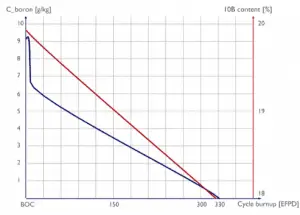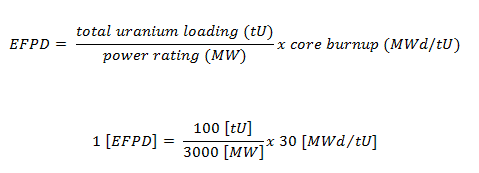
A commonly used unit that describes the state of the fuel is the Effective Full Power Day (EFPD). It specifies the burnup of a given fuel assembly by the number of days it has resided in the core while the core was operated at full power. This unit is commonly used especially for cycle burnup description. For example, a typical 18-month fuel cycle requires an excess of reactivity for 500 EFPDs. It means the core must be refueled after 500 days at 100% rated power or after 1000 days at 50% rated power. The relation between EFPD and MWd/tU is:
Fuel Burnup – Core Burnup
Fuel burnup (also known as fuel utilization) measures how much energy is extracted from nuclear fuel and measures fuel depletion in nuclear engineering. The most commonly defined as the fission energy release per unit mass of fuel in megawatt-days per metric ton of heavy metal of uranium (MWd/tHM) or similar units. Fuel burnup defines energy release as well as defines the isotopic composition of irradiated fuel. Since during refueling, every 12 to 18 months, some of the fuel – usually one third or one-quarter of the core – is replaced by fresh fuel assemblies, and power distribution is not uniform in the core, reactor engineers distinguish between:
- Core Burnup. Averaged burnup over entire core (i.e., over all fuel assemblies). For example – BUcore = 25 000 MWd/tHM
- Fuel Assembly Burnup. Averaged burnup over single assembly (i.e., overall fuel pins of a single fuel assembly). For example – BUFA = 40 000 MWd/tHM
- Pin Burnup. Averaged burnup over a single fuel pin or fuel rod (overall fuel pellets of a single fuel pin). For example – BUpin = 45 000 MWd/tHM
- Local or Fine Mesh Burnup. Burnup significantly varies also within a single fuel pellet. For example, the local burnup at the rim of the UO2 pellet can be 2–3 times higher than the average pellet burnup. This local anomaly causes the formation of a structure known as a High Burnup Structure.
